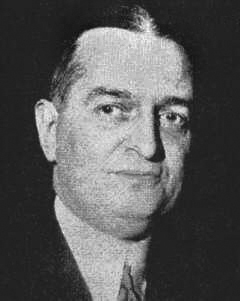Joseph Force Crater Declared Legally Dead, 1939
 |
| "The Missingest Man in New York" |
Certainly he isn't the only man who's ever become a missing person. The story wouldn't be unusual, except for the fact that Joseph Crater was an Associate Judge for the New York Supreme Court -- and that some of his business relationships were a little suspect.
Crater had been appointed to the Court only four months before he disappeared. Just days before his appointment, he withdrew $20,000 from the bank. That would be about $265,000 in today's money, and it was the equivalent of about a year's salary. It was also the going rate for judge appointments in the corrupt political system known as Tammany Hall.
Shortly before he disappeared, Crater was vacationing with his wife at a cabin in Belgrade, Maine. He received a phone call. He didn't tell his wife what the call was about, but stated that he needed to go to New York to "straighten those fellows out."
Whether or not he straightened anyone out is unknown, but he did go to Atlantic City with his mistress. On August 1st he returned to Maine, and then on August 3rd he was back in New York again. He promised his wife that he would be back for her birthday on the 9th.
On August 6th, Crater spent two hours going through his papers, and then sent his assistant to the bank to cash two checks for him, totaling $5,150 (about $68,500 in today's money.) At noon, he and his assistant took two locked suitcases to Crater's New York apartment, and Crater gave his assistant the rest of the day off.
That evening, Crater bought a ticket for a Broadway show that was playing later that night, and then joined his mistress and a lawyer friend for dinner. He left shortly after 9:00 pm, and his friends last saw him walking down the sidewalk. And that was the last anyone saw of Judge Crater.
He wasn't missed initially, and by the time his wife called the New York police, he had been missing nearly a week. The two suitcases were nowhere to be found, and the contents of Crater's safety deposit box were gone as well. After a grand jury investigation, with 95 witnesses and 975 pages of testimony, the conclusion was that there was no conclusion. No one could determine if Crater was alive, dead, or a victim of amnesia. On June 6, 1939, he was declared legally dead in absentia. The case was so well-known that the phrase "pull a Crater" came to mean to disappear permanently.
That's not quite the end of the story, however. In 2005, a woman named Stella Ferruci-Good died and in her effects a letter was found, marked "Do Not Open Until My Death." The letter claimed that Crater was buried under the boardwalk at a location in Coney Island, Brooklyn, and that he had been killed by Mrs. Good's husband, Robert, and two other men, Frank and Charles Burns. Robert Good and Charles Burns were both NYPD officers. Charles Burns also worked as the personal bodyguard of Abe Reles, a well-known hit man for Murder, Inc. The site is now the location of the New York Aquarium. There are no extant records showing what, if any, remains were found in that area in the 1950's.
First Drive-In Movie Opens, 1933
 |
| Hollingshead's outdoor theater. |
The drive-in had room for 500 cars, and he advertised it with the slogan, "The whole family is welcome, regardless of how noisy the children are." It only operated for three years, but that was time enough for the idea to catch on. By the time Hollingshead's drive-in had closed, three more that had opened in several states. They really took off in the 1950's and early 1960's however -- by that time there were more than 4,000 drive-in theaters across the country.
No comments:
Post a Comment